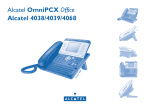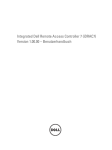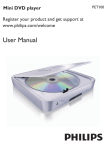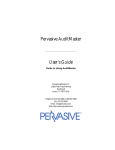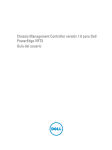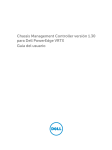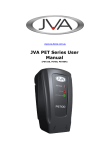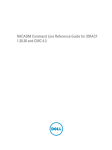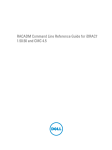Download Dell Lifecycle Controller 1.3 White Paper
Transcript
Enhancements to iDRAC7 Alert
Notification
This Dell white paper discusses the improvements made to the
iDRAC7 version 1.30.30 alerting capabilities
Test Engineer
Enterprise Software Validation
Test Engineer
Enterprise Software Validation
Firmware Engineer
Enterprise Firmware
Enhancements to iDRAC7 Alert Notification
Contents
Executive summary ................................................................................................................................................... 3
Introduction ............................................................................................................................................................... 3
Feature enhancements ............................................................................................................................................ 3
Filtering alerts by category and severity levels ................................................................................................. 4
Setting event alerts................................................................................................................................................ 5
Email alerts ......................................................................................................................................................... 6
SNMP Trap alerts ............................................................................................................................................... 8
IPMI PET alerts ................................................................................................................................................. 10
Remote System Log alerts ..............................................................................................................................12
WS Eventing alerts ............................................................................................................................................13
Testing configured events ................................................................................................................................. 14
Configuring network settings for alerts .......................................................................................................... 14
Summary ....................................................................................................................................................................15
Figures
Figure 1.
Alert categories and severity levels .................................................................................................. 4
Figure 2.
Alert types ............................................................................................................................................. 5
Figure 3.
Email alert configuration .................................................................................................................... 6
Figure 4.
Authenticated email alert configuration ......................................................................................... 6
Figure 5.
Configuring SNMP Trap alerts ........................................................................................................... 8
Figure 6.
Setting a destination address ............................................................................................................ 9
Figure 7.
Sample alert for a chassis intrusion event ...................................................................................... 11
Figure 8.
Configuring Remote System Log alerts .........................................................................................12
Figure 9.
Remote Syslog Settings .....................................................................................................................12
Figure 10.
Configuring WS Eventing alerts .......................................................................................................13
Figure 11.
Testing a configured event .............................................................................................................. 14
This document is for informational purposes only and may contain typographical errors and technical
inaccuracies. The content is provided as is, without express or implied warranties of any kind.
© 2013 Dell Inc. All rights reserved. Dell and its affiliates cannot be responsible for errors or omissions in
typography or photography. Dell, the Dell logo, OpenManage, and PowerEdge are trademarks of Dell Inc. Other
trademarks and trade names may be used in this document to refer to either the entities claiming the marks and
names or their products. Dell disclaims proprietary interest in the marks and names of others.
January 2013 | Version 1.0
ii
Enhancements to iDRAC7 Alert Notification
Executive summary
Alerts and actions can be set for certain events that occur on Dell™ PowerEdge™ servers. Event alerts
provide immediate notification about an event, plus information about the action the system requires
to address the event.
The newest version of the Integrated Dell Remote Access Controller (iDRAC7 version 1.30.30) for Dell
th
PowerEdge 12 generation servers support more types of alert mechanisms and improves the user
experience through an updated web interface. With the latest enhancements, all of the alert features
now focus more on out-of-band support without the need to install additional host software.
Introduction
The iDRAC7 with Lifecycle Controller is a Dell systems management solution for Dell PowerEdge
servers. These controllers provide a way of proactively notifying IT administrators of abnormalities,
called events, that may cause interruptions or system failure.
Events occur when the status of a component is outside the range of a predefined condition. An event
notification occurs when alerts and actions are set. If an event matches a filter, and the filter is
configured to generate an alert, an alert is sent to a preconfigured destination.
Alerts can take the form of an email alert, Simple Network Management Protocol (SNMP) alert,
Intelligent Platform Management Interface (IPMI) alert, remote system log (syslog) alert, or Web
Services (WS) Events alert. Each individual event can also be set with a different system action
including power cycle, reboot, and power off.
To arrange immediate notification in the case of an event, you can set alerts and actions using the
iDRAC7 web interface or command-line interface (CLI). Alerts provide information about events and
allow you or the system to take the necessary action to remedy an event before a system failure
occurs causing costly downtime in the data center. iDRAC7 now supports more types of alerts and
offers an improved, user-friendly web interface.
Feature enhancements
Management controllers on previous generation Dell servers—early DRAC and iDRAC versions, and the
baseboard management controller (BMC)—supported only Platform Event Trap (PET) alerts. These
IPMI alerts were confined to events generated by IPMI sensors, and did not include events generated
by subsystems such as storage or memory.
Additionally, only servers with Dell OpenManage™ Server Administrator (OMSA) could send SNMPv1
alerts. With the latest version of iDRAC7, SNMP alerts no longer require an operating system or agent
such as OMSA. With the latest enhancements to the alert notification feature in iDRAC7, monitoring
your PowerEdge systems is easier than ever. These feature enhancements include:
Out-of-band SNMP alerts
Authenticated email alerts
Events logging to remote syslog
3
Enhancements to iDRAC7 Alert Notification
Additional alert subsystem categories
Column-separated information, such as severity type (info, warning, and critical), category type,
and action type
Recommended actions specified for each alert
Support for SNMPv1 and SNMPv2 alerts
No requirement for an operating system agent for SNMP alerts, meaning no additional software
installations for the host operating system
Fully qualified domain name supported for email, SNMP, and IPMI alert destinations
Capability for testing configured events
Filtering alerts by category and severity levels
You can sort and search for alerts by either category or severity using the iDRAC7 web interface.
Supported alert category types in include:
System Health
Storage
Configuration
Audit
Updates
Work Notes
Supported alert severity types in include:
Critical
Warning
Informational
You can select as many alert categories or severity levels as you need when searching for alerts. See
Figure 1.
Figure 1.
Alert categories and severity levels
Note: Alert filters are session based. The selected alert filters will revert to the default state once you
refresh the page or end the session.
4
Enhancements to iDRAC7 Alert Notification
Setting event alerts
You can configure iDRAC7 to send alerts to configured destinations for a variety of events. The types
of event alerts, as shown in Figure 2, include the following:
Email
SNMP Trap
IPMI
Remote System Log
WS Eventing
Figure 2.
Alert types
You can configure alerts using the iDRAC7 web interface or the Remote Access Controller Admin
utility (RACADM) CLI. For more information on the web interface, see the online help or the Integrated
Dell Remote Access Controller 7 (iDRAC7) Version 1.30.30 User's Guide. For more information on the
CLI, see the RACADM Command Line Reference Guide for iDRAC7 1.30.30 and CMC 4.3.
5
Enhancements to iDRAC7 Alert Notification
Email alerts
Configuring email alerts using the iDRAC7 web interface
1.
Select Overview > Server > Alerts > SNMP Traps and Email Settings.
2. Select State and enter the destination email address and the email server address.
3. Click Send under Test Email to test the configured email alert settings.
4. Click Apply.
Figure 3.
Email alert configuration
To use the new authenticated email alert option:
1.
Select Enable Authentication.
2. Enter the Username and Password for the user who has access to SMTP server.
3. Enter a valid IP address or the fully qualified domain name (FQDN) of the SMTP server in the SMTP
(Email) Server IP Address or FQDN/DNS Name field.
Authenticated email alerts require a username and password to access the domain where the mail
server is located. Transport Layer Security (TLS) is used and credentials are verified before emails are
delivered.
Figure 4.
Authenticated email alert configuration
6
Enhancements to iDRAC7 Alert Notification
Configuring email alerts using RACADM commands
To configure the SMTP email server:
set command
racadm set iDRAC.RemoteHosts.SMTPServerIPAddress <SMTP Email Server IP
Address>
config command
racadm config -g cfgRemoteHosts -o cfgRhostsSmtpServerIpAddr <SMTP
Email Server IP Address>
To enable email alerts:
config command
racadm config -g cfgEmailAlert -o cfgEmailAlertEnable -i [index] [0|1]
where [index] is the email destination index and 0 disables the email alert or 1 enables the alert
The email destination index can be a value from 1 through 4. For example, to enable email
with index 4, use the following command:
racadm config -g cfgEmailAlert -o cfgEmailAlertEnable -i 4 1
set command
racadm set iDRAC.EmailAlert.Enable.[index] 1
where [index] is the email destination index and 0 disables the email alert or 1 enables the alert
The email destination index can be a value from 1 through 4. For example, to enable email
with index 4, enter the following command:
racadm set iDRAC.EmailAlert.Enable.4 1
To configure email settings:
config command
racadm config -g cfgEmailAlert -o cfgEmailAlertAddress -i 1 [emailaddress]
where 1 is the email destination index and [email-address] is the destination email address that
receives the platform event alerts
set command
racadm set iDRAC.EmailAlert.Address.1 [email-address]
where 1 is the email destination index and [email-address] is the destination email address that
receives the platform event alerts
7
Enhancements to iDRAC7 Alert Notification
To configure a custom message:
config command
racadm config -g cfgEmailAlert -o cfgEmailAlertCustomMsg -i [index]
[custom-message]
where [index] is the email destination index and [custom-message] is the custom message
set command
racadm set iDRAC.EmailAlert.CustomMsg.[index] [custom-message]
where [index] is the email destination index and[custom-message] is the custom message
To test the configured email alert, if required:
racadm testemail -i [index]
where [index] is the email destination index to test
SNMP Trap alerts
In previous generations of Dell PowerEdge servers, SNMP alerts were supported only for in-band
th
through OMSA. The Dell PowerEdge 12 generation servers with iDRAC7 support SNMP out-of-band
alerts. SNMP trap alerts are currently supported in two different types of formats: SNMPv1 and
SNMPv2.
Configuring SNMP trap alerts using the iDRAC7 web interface
You can configure SNMP alerts for any alert category by selecting the check box under SNMP Trap to
enable an SNMP alert for the event category. See Figure 5.
Figure 5.
Configuring SNMP Trap alerts
8
Enhancements to iDRAC7 Alert Notification
You can then configure up to eight destination addresses for delivery of any SNMP alert. You can
configure the destination address using IPv4 address, IPv6 address, or a FQDN. See Figure 6.
To receive the SNMP alert, the community string for iDRAC needs to be the same as the destination
community string. By default, the value of the iDRAC community string is set to public. See Figure 6.
Figure 6.
Setting a destination address
Configuring SNMP trap alerts using RACADM commands
To configure the trap destination address for IPv4:
racadm config -g cfgIpmiPet -o cfgIpmiPetAlertDestIPAddr -i [index]
[IP-address]
where [index] is the trap destination index and [IP-address] is the destination IP address of the
system that receives the platform event alerts
To configure the trap destination address for IPv6:
racadm config -g cfgIpmiPetIpv6 -o cfgIpmiPetIpv6AlertDestIPAddr -i
[index] [IP-address]
where [index] is the trap destination index and [IP-address] is the destination IP address of the
system that receives the platform event alerts
9
Enhancements to iDRAC7 Alert Notification
To configure the SNMP community name string:
config command
racadm config -g cfgIpmiLan -o cfgIpmiPetCommunityName [name]
where [name] is the SNMP Community Name
set command
racadm set iDRAC.SNMP.AgentCommunity [name]
where [name] is the SNMP Community Name
To test the trap, if required:
racadm testtrap -i [index]
where [index] is the trap destination index
To configure the trap format:
racadm set iDRAC.SNMP.TrapFormat [format]
where [format] is the SNMP v1 or SNMP v2 format; the value can either be set to 0 or 1
IPMI PET alerts
Most Dell PowerEdge servers with iDRAC7 support IPMI PET alerts. The IPMI trap event format is
specified in the PET specification (see http://download.intel.com/design/servers/ipmi/PET100.pdf). To
help decode IPMI trap information, Dell provides a Management Information Base (MIB) file
(DcAsfSrv.mib) on the OpenManage DVD and on Support.Dell.com.
IPMI alerts are more difficult to decode than SNMP alerts. You need to correlate events with the MIB
file and/or sensor information to decode an IPMI alert. You can retrieve sensor information from
iDRAC7 using a standard IPMI utility, such as ipmitool, which is also located on the OpenManage DVD
and on Support.Dell.com.
10
Enhancements to iDRAC7 Alert Notification
To demonstrate decoding an IPMI PET alert, see the sample in Figure 7 of an alert caused by a chassis
intrusion event.
Figure 7.
Sample alert for a chassis intrusion event
In the trap details, note the contents of the Specific Type field, which are 356096 in this sample.
Match 356096 to the DcAsfSrv.mib file, which has the following information for a chassis intrusion
event:
-- Intrusion --- Intrusion
asfTrapCaseIntrusion TRAP-TYPE
ENTERPRISE asfPetEvts
DESCRIPTION
"Chassis Intrusion - Physical Security Violation"
--#SUMMARY
"Chassis Intrusion - Physical Security Violation"
--#ARGUMENTS
{}
--#SEVERITY
CRITICAL
::= 356096
You can also decode the contents of the Message field using the PET specification, which indicates a
number of items such as the sensor number and the event severity.
11
Enhancements to iDRAC7 Alert Notification
Remote System Log alerts
th
Using iDRAC7 for Dell PowerEdge 12 generation servers, you can configure alerts to be send to a
remote syslog. To send an event alert to a remote syslog sever, select the corresponding check box
under Remote System Log. See Figure 8.
Figure 8.
Configuring Remote System Log alerts
Note: Remote syslog is an Enterprise level license feature, and is not available at the Express level.
Configuring remote syslog in the iDRAC7 web interface
1.
Select Overview > Server > Logs > Settings.
2. Select the Remote Syslog Enabled check box.
3. To define the server location, enter the destination server address in the Syslog Server field and
enter the Port Number.
4. Click Apply.
Figure 9.
Remote Syslog Settings
12
Enhancements to iDRAC7 Alert Notification
Configuring remote syslog using RACADM commands
To enable remote syslog:
config command
racadm config –g cfgRemotehosts –o cfgRhostsSyslogEnable [number] where [number] is to disable [0] or enable [1] the remote syslog
set command
racadm set iDRAC.Syslog.SyslogEnable [number]
where [number] is to disable [0] or enable [1] the remote syslog
To set a destination address for a remote syslog:
config command
racadm config –g cfgRemotehosts –o cfgRhostsSyslogServer[#] {address}
where [#] is number of the syslog server, user can configure up to 3 servers and {address} is
the IP address of the destination server
set command
racadm set iDRAC.Syslog.Server[#] {address}
where [#] is number of the syslog server, user can configure up to 3 servers and {address} is
the IP address of the destination server
WS Eventing alerts
th
For Dell PowerEdge 12 generation servers, you can set WS Eventing to receive WS Eventing
notifications. In iDRAC7 1.30.30, WS Eventing only supports job control events that are found in the
configuration category. WS Eventing defines a protocol for a client service (subscriber) to register
interest (a subscription) with a server web service (event source) to receive the messages containing
the server events (notifications or event messages).
To set WS Eventing for a configuration event, select the corresponding check box under WS Eventing.
See Figure 10.
Figure 10.
Configuring WS Eventing alerts
13
Enhancements to iDRAC7 Alert Notification
Testing configured events
After configuring alerts, you can test the configuration of each event.
1.
In the IDRAC7 web interface, enter the message ID of an alert in the Message ID to Test Event
field. See Figure 11.
For a list of valid message IDs, see the Dell Event Message Reference or the Dell Event/Error
Message Reference 2.0 on Dell.com.
Each alert message starts with a three- or four-character code to identify the problem area. This
code is followed by a three- or four-digit number that specifies the actual error.
2. Click Test to send the configured event to the respective SNMP, IPMI, email, remote syslog, and
WS Eventing alerts.
Figure 11.
Testing a configured event
Configuring network settings for alerts
For alerts to work correctly, you must configure the iDRAC7 network settings for a DNS server and a
domain name. You can configure the iDRAC7 network settings using either the iDRAC7 web interface
or RACADM CLI.
Configuring networks settings in the iDRAC7 web interface
1.
Select Overview > iDRAC Settings > Network.
2. Under Common Settings select Register DRAC on DNS.
3. In the same section, either select Auto Config Domain Name, or enter a static DNS Domain
Name.
4. Under IPv4 Settings, either select Use DHCP to obtain DNS server addresses, or manually enter
the IP address of your DNS server.
5.
For IPv6, you can use the Autoconfiguration Enable feature, or manually enter the IP and DNS
information. When using IPv6, make sure you specify the iDRAC DNS domain name under
Common Settings.
Configuring networks settings using RACADM commands
For instructions, see the RACADM Command Line Reference Guide for iDRAC7 1.30.30 and CMC 4.3.
14
Enhancements to iDRAC7 Alert Notification
Summary
The alert enhancements in the iDRAC7 1.30.30 firmware release provide IT administrators with more
options, methods, and granularity to manage Dell PowerEdge servers. Key improvements include:
Improved web interface that is more user friendly
Individual alert messages with recommended actions for resolving events
Alerts for more subsystem categories such as storage and configuration
Additional types of alerts including SNMP, WS Events, authenticated email, and remote syslog
Additionally, you can receive alerts for servers that have no operating system installed, and therefore,
no need for installing an operating system agent such as OMSA. You can configure alert destinations
using a fully qualified domain name instead of an IP address. Plus you now have the ability to search
and view the newly standardized message database using the iDRAC7 web interface.
Dell continues to listen to our customers and provide features that meet the needs of the
ever-changing IT world. By adding these enhancements to the alerting feature, administrators have
much more flexibility to configure alerts for their specific environment.
More information on iDRAC7 version 1.30.30
For more information on iDRAC7 version 1.30.30, see Support for Integrated Dell Remote Access
Controller 7 Version 1.30.30 on Dell.com.
15
















